Italian Battleships during WW2 were few in numbers, just as French ones, due to the treaty of Washington signed in 1920. But the Regia Marina tried to maintain more than a parity with its Transalpine rival in the Mediterranean, its WW1 capital ships were completely modernized in a way few fleets did while its projected battleships were quite impressive, such as the Carracciolo and pre-treaty postwar projects that would have dwarved anything in the Mediterranean.
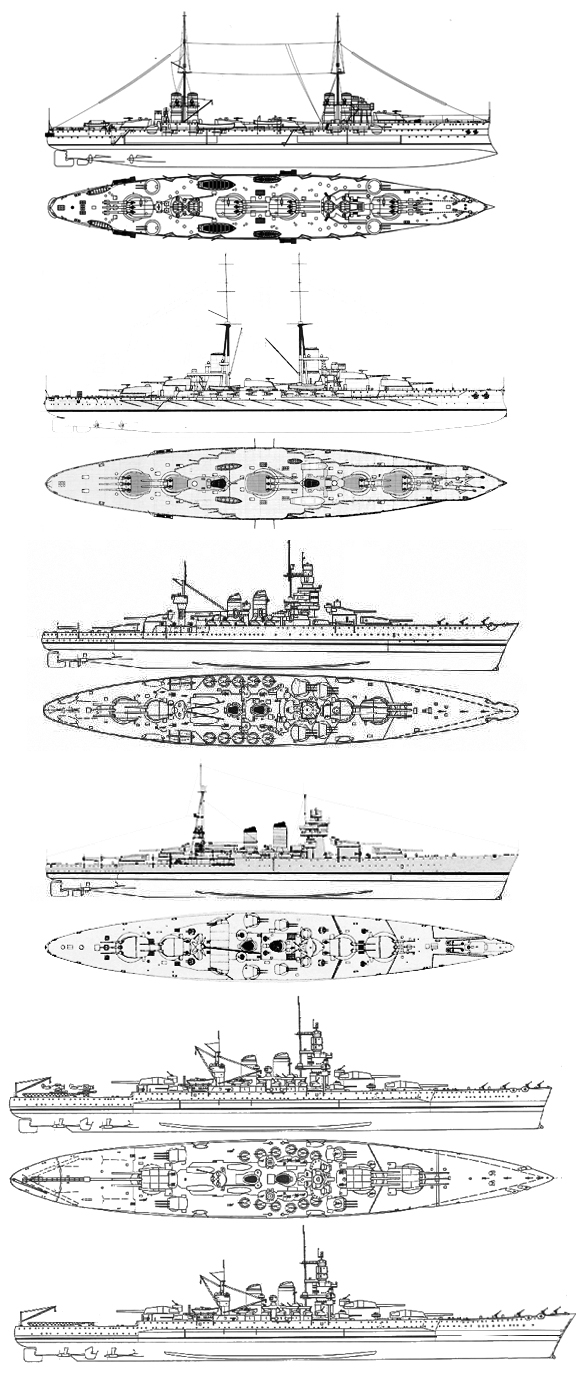
Overview of Italian battleships, interwar to WW2
The Littorio, an answer to the French Dunkerque which in turn, already answered the Deutschland class proceeded from a long reflection and ended eventually with an artillery solution that became mainstream by the 1940s. Naval plans in WW2 were shattered as situation changed quickly and prevented to complete the last one, RN Impero. With the fall of France in June 1940 the French fleet was in principle left out of the equation, making on paper the Regia Marina, the dominant force in the Mediterranean.
However there was still an obstacle before Mussolini could complete his dream of “Mare Nostrum”: The Royal Navy, willing to protect both the vital Suez canal, Gibraltar, and Malta in between, fought tooth and nails with the Mediterranean fleet, and both under masterful management by Andrew Cunningham on one side, best use of radar and naval air force, and a more timid command, the lack of radar, and absence of efficient coordination with the Regia Aeronautica decided of the Mediterranean theater: From November 1940 in Tarento, the Italian pearl Harbour, to Matapan, a decivive night fighting, and despite their quality, Italian battleships won’t prevail and ultimately succumb to …German flying bombs, early anti-ship “missiles” in November 1943.
The fate of Dante Aligheri
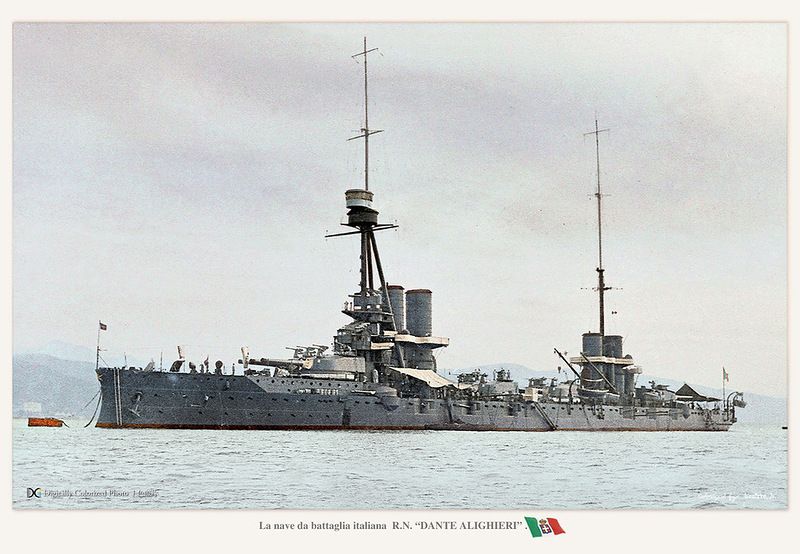
Dante Aligheri in 1924 – Colorized by Irootoko Jr. More Italian colorization here.
The first Italian dreadnought took a well defined path, which also influence the Russian and and their Austro-Hungarian rivals. They were the only one to use triple turrets, whereas the British, German, French, Americans and Japanese all capitalized in twin turrets. In the early years of the dreadnought, there were doubts about whether it was possible or not to have superimposed turrets. We have to remind that the HMS Dreadnought and following classes had deck-level artillery only, on so were the early Nassau and Helgoland class in Germany. The first to break this engineering wall of using massive superimposed turret were actually not the Brazilians with the Minas Gerais class, started in 1907, but by the Americans with the South Carolina class started in 1906. They showed the way, and rapidy the French followed with the Courbet class. However for the Italians, the minds were set on a triple artillery solution early on, and having these massive turrets in superimposing position, as attractive the idea was, seemed far fetched. They were all placed on deck level, even if this meant to be forced to reduce the overall armour thickness in order to cover a larger area, and to solve secondary armament barbettes placements, eight guns were in twin turrets, long before anyone else. This made the unique RN Dante Aligheri quite original for the time, and the Ansaldo design prepared for the Russian Gangut was basically a close inspiration.
Below are three Ansaldo proposals for Russia, all three of a 23,000 tonnes, triple turret configuration battleship.
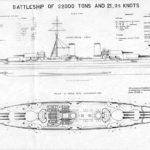
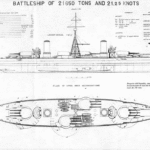
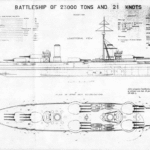
All three were prepared by Guiseppe Tavola, chief engineer at Ansaldo in 1908.
-Design A (left) was a 23,000 tonnes standard, 176m x 28m x 8,15m, 21knots, armored with 203mm/102mm Upper belt, 102mm decks, 256 mm CT, 51 mm ASW longit. bulkheads and armed with 6×3 305mm, 16×1 120mm Casemated Guns.
-Design B (middle) was a 21.650 tons project, 167m x 27m x 8,15m, 21,25 knots, same armor but 4×3 305 mm Cannons
-Design C (right) was a 22.000 tons project, 178m x 27m x 8,15m, same speed, same armor and armament but different configuration.
This leaves quite a grasp of what the Italians could have produced of not budget constrained to a specific tonnage. The “A” proposal would have, with no less than 18 12-inches guns, be a serious adversary for anything else at the time, but perhaps HMS Agincourt and her 14 guns. But the all-axial solution was nevertheless seductive in that no firepower was wasted in batteline broadside fire. The final Italian design was nowhere near these protection figures, with at best 250 mm on the belt, 280 for the CT, but 22.8 knots, which was better than many BBs of the time. The Austro-Hungarians with their Tegetthof still choose to take the engineering risk of having four triple superimposed turrets, less of bravado than forced by the size of the Yard’s basin. And the Italians, seeing the path recoignised beforehand, followed suite with the Cesare class.
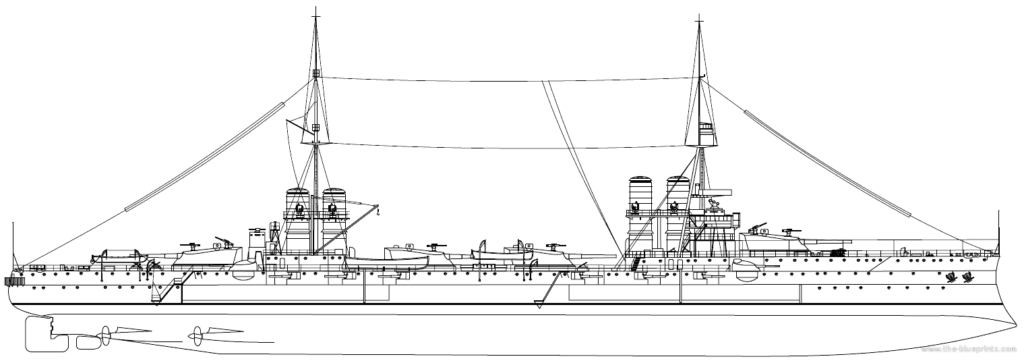
Blueprint of the Dante in 1924
In the end, Dante Aligheri, started at Castellammare di Stabia in 1909, served the Regia Marina from 1913, up to 1922 where the Washington treaty put her very existence to question. Would have it be judicious to scrap her and free some tonnage ? In the end it was chosen to convert her as a training ship, modernized. Dante was at the same time, the first modernized Italian battleship of the interwar, and the least modified, as it was known her days were counted.
Her interwar modernization was mostly cosmetic: Starting in 1923, she had a tripod foremast installed to support a modern fire control system for the main artillery, and a catapult installed on the roof of Turret no. 3 for artillery spotting, plus heightening the funnels to have smoke interference less sensitive. The AA was modernized by removing the old 3-in, replaced by two 40mm Vickers AA guns. In 1924 the experimental fire-control system made a test campaign. She would serve until 1928 and as it became apparent Italy could not longer afford to maintain her fleet, chosed to sent her in reserved, and then scrapping from July 1, 1928. If the economic situation would improve, perhaps the Dante would have been rebuilt anew in the late 1930s, but that seems far fetch. The Cavour and Cesare class, better protected and armed, seemed an all-more seductive proposition.

What-if late 1930s modernization of the Dante Aligheri
Cavour class (1913)
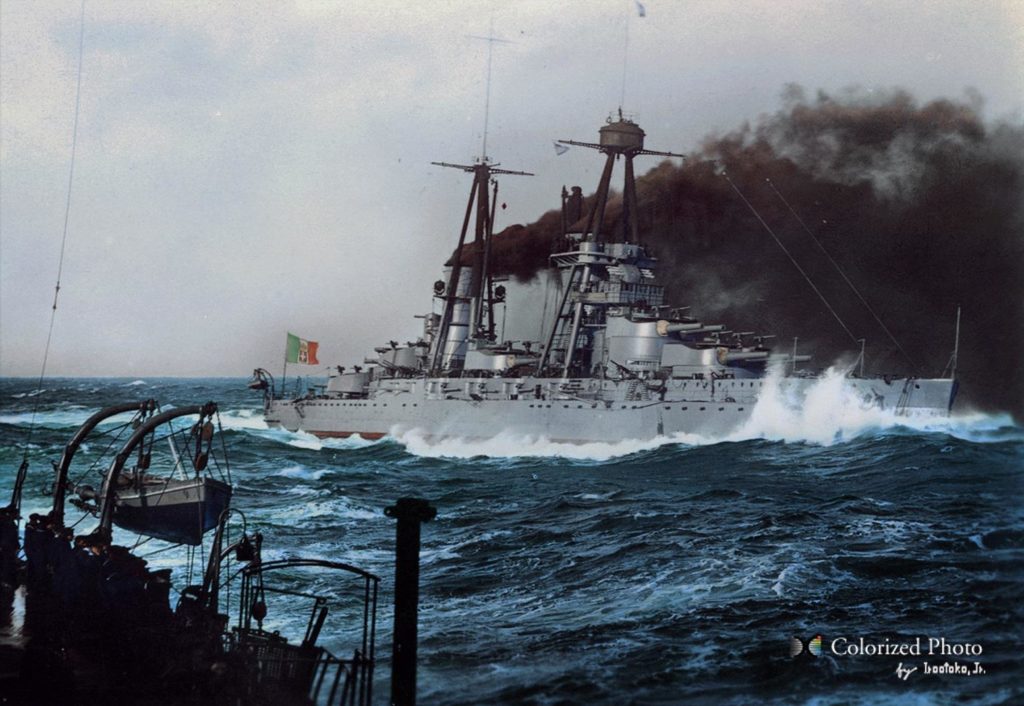
The Guilio Cesare at sea in the interwar, dramatic photo colorized by Irootoko jr.
The Cesare was launched in 1913 as a Dreadnought (single-caliber battleships). It was the seed of three vessels (Conte de Cavour class) put on hold in 1910 and launched in 1911, completed in 1913-1914. The Leonardo Da Vinci, third in the class, was destroyed by an explosion in an ammunition bay in 1916 and scrapped in 1923. In 1932-33, the two remaining ships were placed in reserve or training, then rebuilt in Genoa (Cesare) and Trieste (Cavour) in October 1933. This absolutely radical overhaul, unprecedented in naval history led by Vice-Admiral and General of Naval Engineering Francesco Rotundi included:
-New engines and boilers, 2 new shafts, new propellers, new oil heated boilers, new funnels, new turbines for much increased performance.
-Two new masts, new gangway superstructure, new bridge, new rangefinders and optical instruments, radio and Wireless TF.
-Newly recast main cannons, rebored and relined from 305mm to 320mm, higher elevation and better range, redesigned turrets.
-A secondary artillery in turrets (removal of barbettes), in 6 twin 120mm turrets.
-AA with 6 dual purpose 102mm and 12 37mm turrets, plus 12 dual 13mm Breda heavy machine gun mounts.
-An elongated hull with a redesigned bow and revised waterlines at the front.
-A completely redesigned armor, with anti-torpedo bulges and increased vertical protection (over the decks and machinery space).
-40% of the old structure was affected from this overhaul.
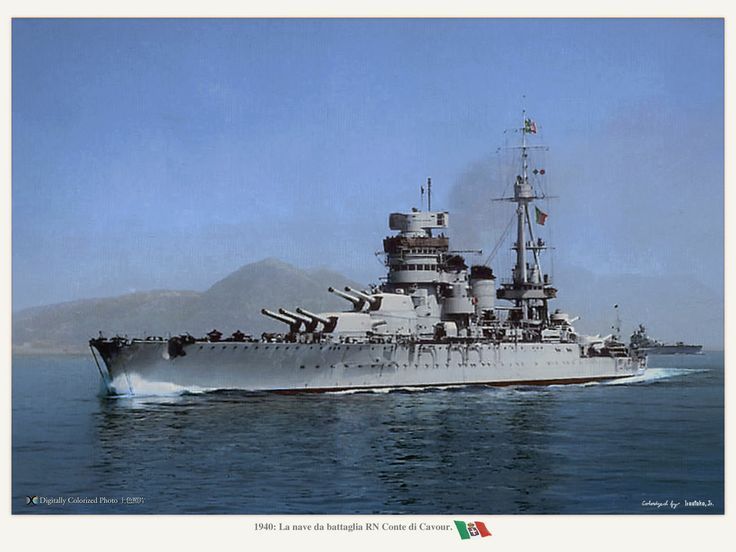
Cavour in 1938, colorized by Irootoko Jr.
In the end, the two ships emerged in June and October 1937 with a new lease of life, and incorporated all the modern standards of their time. They were part of the 1st Naval Division. After a naval review in the Bay of Naples for Hitler in 1938, their first action was on the Albanian coast in May 1939. Then in July 1940, both were at the battle of Punta Stilo (undecided). RN Cesare was hit on this occasion. After repairs, the two ships tried to stop the convoys to Malta, without success. On November 11, 1940, both ships were attacked by a night raid by British Fairey Swordfish and RN Cavour was put out of action for months in Taranto. In fact, Cavour was later escorted after refloating at Trieste for repairs, which were not completed when Italy surrendered in 1943. That was one of the amazing results of this raid by antiquated biplanes. Post-war rearmament plans never materialized and Cavour was scrapped in 1949.
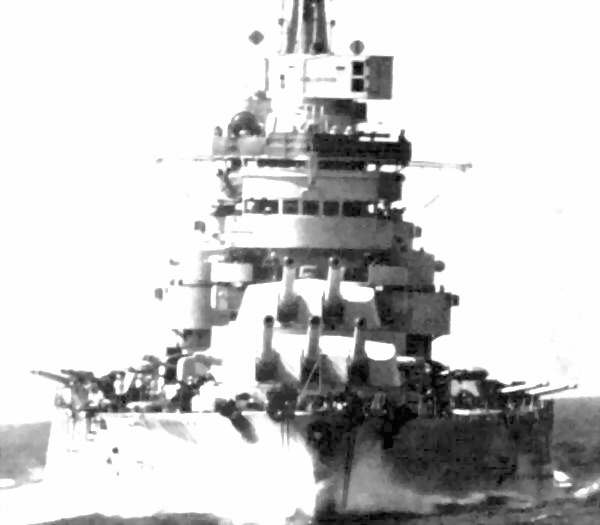
Conte di Cavour underway before November 1940
For her part, RN Guilio Cesare, spared in Taranto, was in action on November 27 at Cape Sparivento, then she hit in Naples during an air attack in January 1941. In December, she was in action at the first battle of the greater Sirta. Subsequently she became a school ship in Pola, sparing fuel, then conveyed to Malta after the armistice to Taranto, and attacked and torpedoed en route by U-596 in March 1944. But she survived. In 1949 she was given to the Soviet navy in repaired renamed Novorrosiysk. The latter modernized her AA in 1953. She was used as a training ship for the Black Sea when in 1955, at night, she was struck by a German drift mine dating from the war. More than 600 sailors perished, and it became the most serious Soviet maritime disaster.
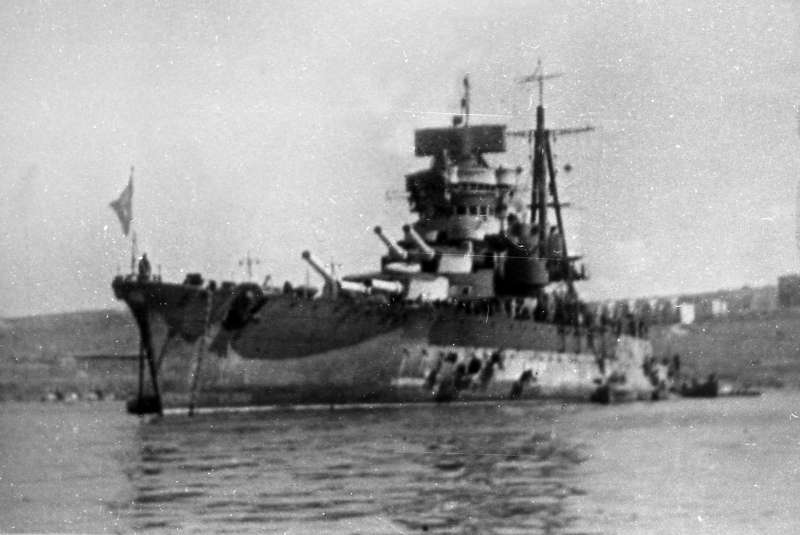
Battleship Novorrossiysk. Notice her camouflage. src: shipspotting.com Her finl camouflage was dark grey on one side and light grey on the other, with the paint splitting her bridge too. This was one of the most intriguing naval camo ever designed, and it was used for observation testings. Given the links the Russian, and later Soviet navy maintained with Italian naval design, she was treated with respect. Read more.
Specifications
Displacement: 29,100 tonnes/29,600 tonnes FL
Dimensions: 186.4 x 33.1 x 9.3m.
Propulsion and performances: 2 shafts geared turbines, 8 Yarrow boilers, 75,000 hp, 27 knots, range 6,400 nautical miles
Armor: Decks 135-166mm, barbettes 130-280mm, belt 130-250mm, CT 250mm.
Armament:10 x 320mm (2×2, 2×3),12 x 120mm (6×2), 4x100mm AA, 12x13mm Breda AA.
Doria class (1914)<
The Caio Duilio class differed from the Conte di Cavour class on many points. Their silhouette in particular was very different, but their armament, dimensions and tonnage were quite similar. After an active career during the First World War, the two buildings were taken over for a major overhaul in 1937 and 1940. This redesign incorporated the experience of the reconstruction of the previous battleships but also the studies undertaken for the construction of the battleships Rapids of the Litorrio class. Their engine apparatus was completely modified, their artillery realized and provided with a greater range.
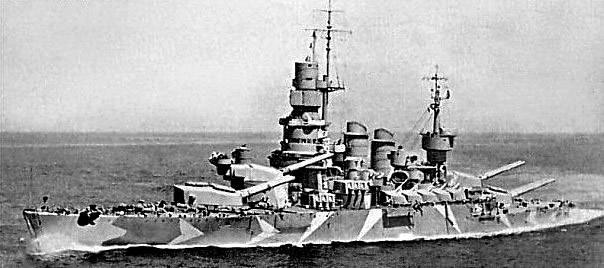
Caio Duilio 1942
The modification points are the same as those of the previous class, with less width and draft, but the main difference concerned secondary armaments:
-Four 135 mm triple turrets (front)
-10 anti-aircraft guns (individual) long range 90mm single mounts guns
-2 twin 37mm mounts, 2 single 20mm AA Breda
-Final tonnage 29,391 tonnes (Duilio) and 28,882 tonnes (Doria)
Back into service
Shortly after its entry into service, the Doria was struck by the torpedo of a swordfish in Taranto and immobilized for months. It was eventually bailed out and brought to Genoa for repairs in May 1941, but did not resume service in 1942 at the November 1943 armistice. It was modernized, received additional AA artillery and a radar and resumed service with the allies. With his sister ship, these two vessels remained in service as a training ship until 1949.

Author’s illustration, 1941
Duilio specifications 1940 |
|
| Dimensions | 186.9 x 29.2 x 8.6m |
| Displacement | 29,100 tonnes /29,400 tonnes FL |
| Crew | 1300? |
| Propulsion | 2 screws, 2 reduction turbines, 8 Yarrow boilers, 90 000 hp |
| Speed | 27 knots (40 km/h; mph) |
| Range | 6,700 nmi () |
| Armament | 10x 355mm (2×2, 2×3), 12 x135mm (4×3), 10 x90mm AA, 12x 37mm, 15x 20mm Breda AA. |
| Armor | Decks 135-166 mm, barbettes 130-280mm, belt 130-250mm, blockhaus 250mm. |
The unfinished Carracciolo class (1916)

Author’s illustration of the Carracciolo
The RN Francesco Caracciolo was the firs Italian ‘super dreadnought’, launched on 12 May 1915 at Castellamare di Stabia. The initial project called for a 35,000 tons battleship capable of 28 knots, with fur triple turrets and twenty 152 mm guns in casemates. Designs were were presented by Ansaldo Yard (engineer Nabor Soliani) and by Orlando Yard (engineer Orlando) but also the Odero Yard (engineer Scribanti). They were presented by General Ferrati, General Carpi and colonels Rota and Russo, Ferrati being the one who decided the best one. As the Italian industry would need to be ramped up and there was no time for this, requirements were lowered to an eight 381 mm guns battleship displacing a more reasonable 31,000 tons. Experiences on models were conducted in La Spezia, at Freude tank, to find what was the best hull shaped. Other scale models were designed to received a reduced underwater protection, tested against light explosives. Venica arsenal worked on the horizontal protection and La Spezia on the oil boilers and the connected pipes.
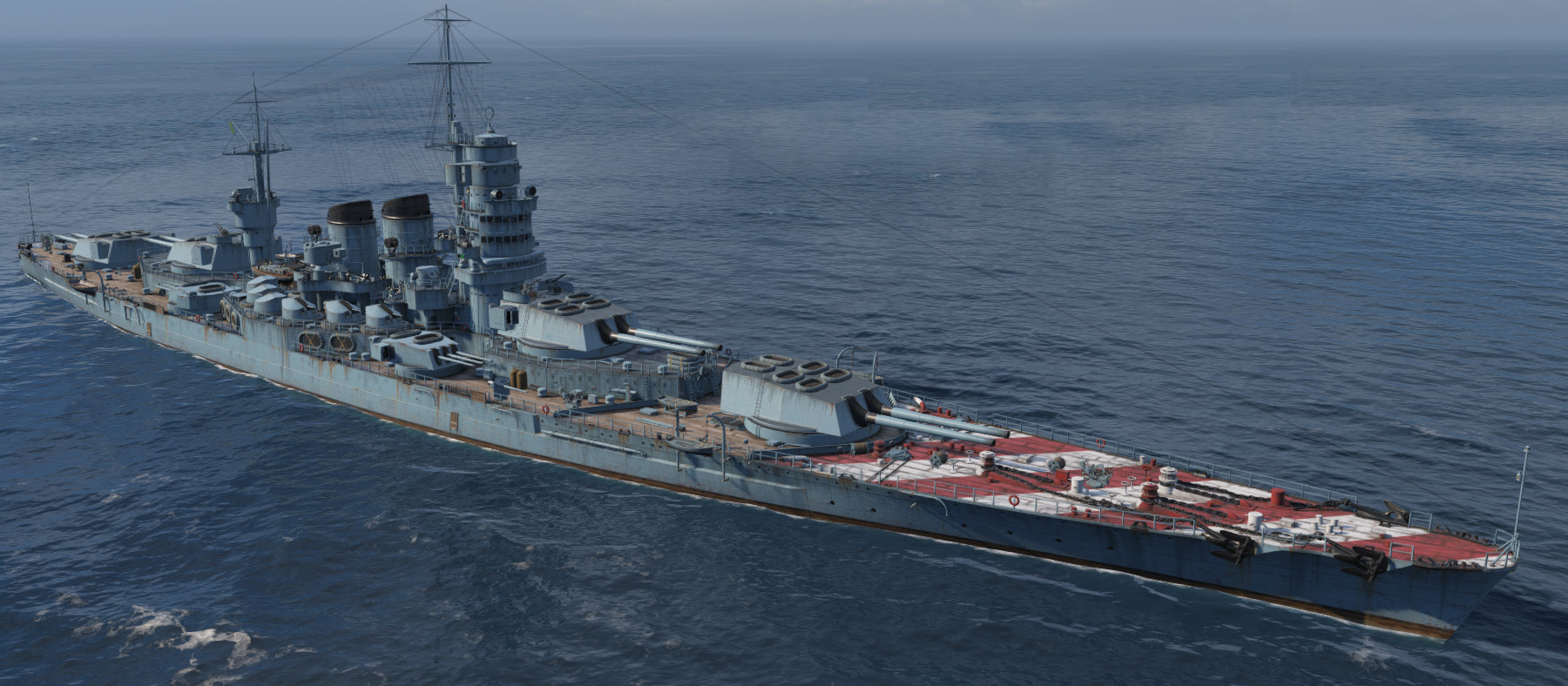
wow’s take on a what-if modernized version of the Carracciolo, if built.
After the design was approved, RN Francisco Carraciolo was laid down on 16 October 1914 at Regio Cantiere di Castellammare di Stabia.
However soon, shortages of steel slowed down the construction to a crawl and after May 1915, the admiralty decided to concentrate instead on lighter ships, destroyers, submarines, and notably gunboats, less expensive and more useful. All work as suspended in March 1916, after it went on slowly for almost a year. 9,000 t of steel already had been assembled so Carraciolo was the most advanced at around 80%. Cristoforo Colombo had only 12.5 percent of her hull complete, 5% of the machinery. The last two, Marcantonio Colonna and Francesco Morosini, started in March and June, only had the keel and few plates assembled when it was halted.
The heavy guns however had been manufactured, and were diverted onto the monitor Faà di Bruno, Alfredo Cappellini, the two Monte Santo, four Monte Grappa-class monitors also used them and the remainder were installed on railway mounts, as Cannone da 381/40 AVS, or in coast-defense positions.
It’s only in October 1919 that work resume, and in 1920, the Regia Marina staff considered converting her as an aircraft carrier. Howevr Italy was by then in a dire economic situation, and compared to the benefits of an Italian pacification campaign in Libya, this plan was dropped. Ansaldo later proposed a cheaper floatplane carrier alternative, to no avail.
Italian navy commanders in addition delayed the adoption of a policy for the interwar Regia Marina, between the traditional surface and decisive battle fleet camp, and a fleet composed of aircraft carriers, torpedo boats and submarines. Admiral Giovanni Sechi argued eventually that a balanced fleet with a small core of good battleships backed with carriers was the most flexible option. As new vessels were planned, Admiral Giovanni Sechi Sechi decided to reduce the number of older capital ships in service and the Francesco Caracciolo class was cancelled. The incomplete lead ship was sold on 25 October 1920 on auction to the Navigazione Generale Italiana shipping company, which planned to convert her as a merchant ship, but but she was evtenually mothballed in Baia Bay (Naples).
The Washington Naval Conference setup a new tonnage limit for the Regia Marina (61,000 metric tons), and the Francesco Caracciolo class was yet again planned to be converted as aicraft carriers. The new design has an island superstructure. Again, budgetary problems soomed the proposal and Francesco Caracciolo was scraped from late 1926 on, the other dismantled in their slip, and the machinery from Cristoforo Columbo recycled in the ocean liner Roma.
Carraciolo specifications 1940 |
|
| Dimensions | 186.9 x 29.2 x 8.6m |
| Displacement | 29,100 tonnes /29,400 tonnes FL |
| Crew | 1300? |
| Propulsion | 2 screws, 2 reduction turbines, 8 Yarrow boilers, 90 000 hp |
| Speed | 27 knots (40 km/h; mph) |
| Range | 6,700 nmi () |
| Armament | 10x 355mm (2×2, 2×3), 12 x135mm (4×3), 10 x90mm AA, 12x 37mm, 15x 20mm Breda AA. |
| Armor | Decks 135-166 mm, barbettes 130-280mm, belt 130-250mm, blockhaus 250mm. |

A photomontage whatif rendition
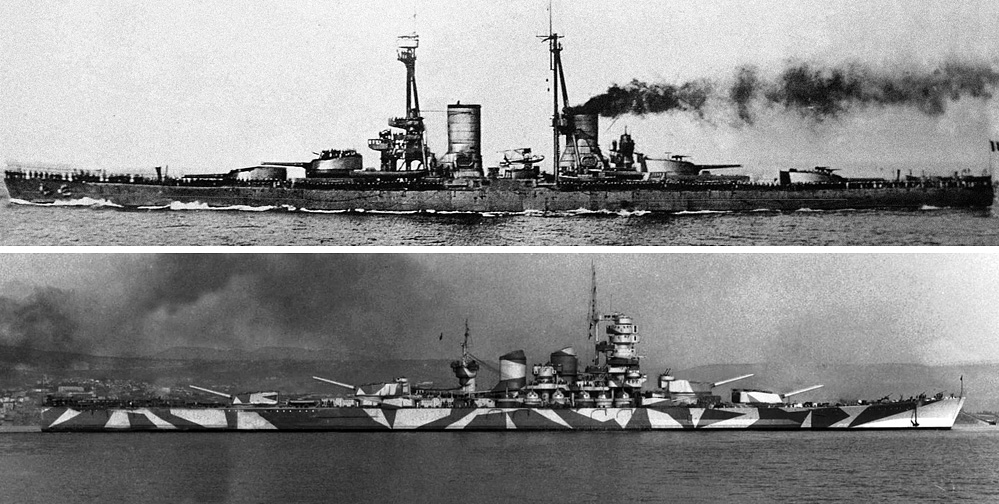
Same idea, with a what-if 1941 camo. Src: Drake’s drum on alternatehistory.com
Progetto G class battleships (1919)
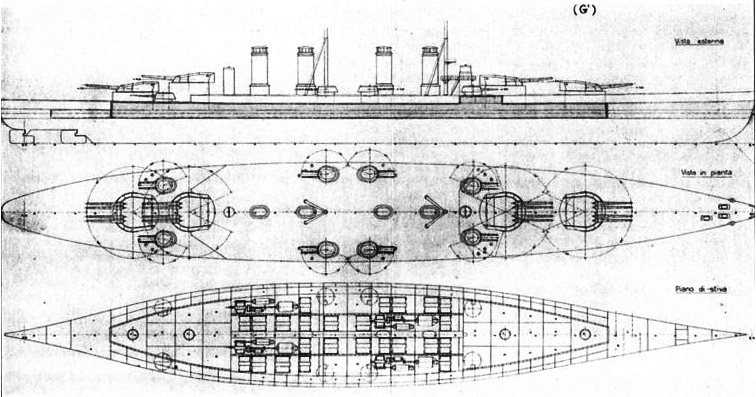
The Project G class battleship on paper was a 37,000 tonnes battleship, before treaty limitations. This was a postwar project which need a radical hull improvement, with only 50 mm of deck armor and no AA. The belt armor was stated as 270 mm and around 300 mm on the turret faces. Progetto G was also supposed to carry sixteen 380 mm guns in four triple turrets and superfiring, quite a radical upgrade compared to the Carracciolo. These were the same guns, but with an improved reloading system to provide up to 2 rpm and a muzzle velocity of 830 m/s with AP shells. Secondary artillery was no longer in barbettes, but in turrets, in all sixteen, and of 170 mm guns (7 in) and no longer 6 in. Configuration was eight twin turrets plus twenty four dual-purpose rapid-fire 102 mm guns, completed by many 40 mm AA guns. This was quite impressive in 1919 and would have been equally so in 1940. The lack of armour was a presumably better speed, as the Carracciolo, and a massive firepower. This would have been a sound calculation, as shown at Jutland, which showed bad visibility nullified range advantages. However shell dispersion would have been a real issue.
Italian Battlecruisers:
Progetto Cassone class (1921)
Ferdinando Cassone proposal was the most ambitious and radical pre-treaty proposal for the Country that first imagine the dreadnought as a game changer. This 1921 proposal was by far the most impressive and ambitious warship ever planned for the Regia Marina. It would have dwarved any other contemporary battleship and even put to shame those of WW2, with only perhaps the Yamato as a contender. The original article which detailed this proposal was published in Rivista Marittima in October, 1921. The article title was “La fase attuale dell’evoluzione delle navi da battaglia (studio critico)” translated as “The ships of the line current evolution status – a critical essay”, signed by Ferdinando Cassone, a naval engineer.
It was a bit of a phantasm, Build to the extreme limit of engineering, and completely outside concrete requirements of the Regia Marina, yards capabilities or budget constraints. It was an extreme case designed to trigger discussion around the optimal battleship design. Of couse, Italy signed the treaty of Washington, which put an end to this speculation.
Cassone in effect made two sketches, and their only visible difference revolved around their secondary artillery layout.
-Dimensions/displacement: 45,000 tonnes, 256 m x 32 m
-Armament: 8 x 456 mm (4×2) main, 6 x 152 mm (2×3) turrets plus perhaps 8-10 more in casemates
-Estimated powerplant: 4 turbines 50,000 HP each, 18 boilers, 216,000 HP, 35-40 knots.
-Armour protection: Main tapered belt or 456 mm down to 350 and 150 mm. Armored Deck 120 mm+ 50 mm 1 deck above.
Cassone stressed indeed a superimposed layout for the engines, with the boilers placed above the turbines, in order to reduce the overall length to protect. This would have allowed to stay within a 45,000 t. tonnage limit. He also made a more classic layout with the Boilers and turbines places at the same level, this time with a displacement of 57,000 t and a lesser top speed.
Progetto Leghorn class (1928)

This was a 1928 battlecruiser design. This Project from O.T.O Livorno was elaborated between 1930-1935, related to a possible alternative transformation of the Cavour and Doria classes. The other option was a brand new unit in conformity of International agreements. She was to displace 26,670 tons for an overall length of 215 m for a beam of 32 m. Top speed as specified was 30 knots. She was to be armed with nine 381 mm guns (3×3), twelve 152 mm guns (6-in) in four triple turrets and twelve 100 mm/32 AA guns, some AA and two quadruple torpedo banks. These specifications were really a basis for the development of the Littorio. This battlecruiser concept went far enough to be materialized into a large yard model. See more.
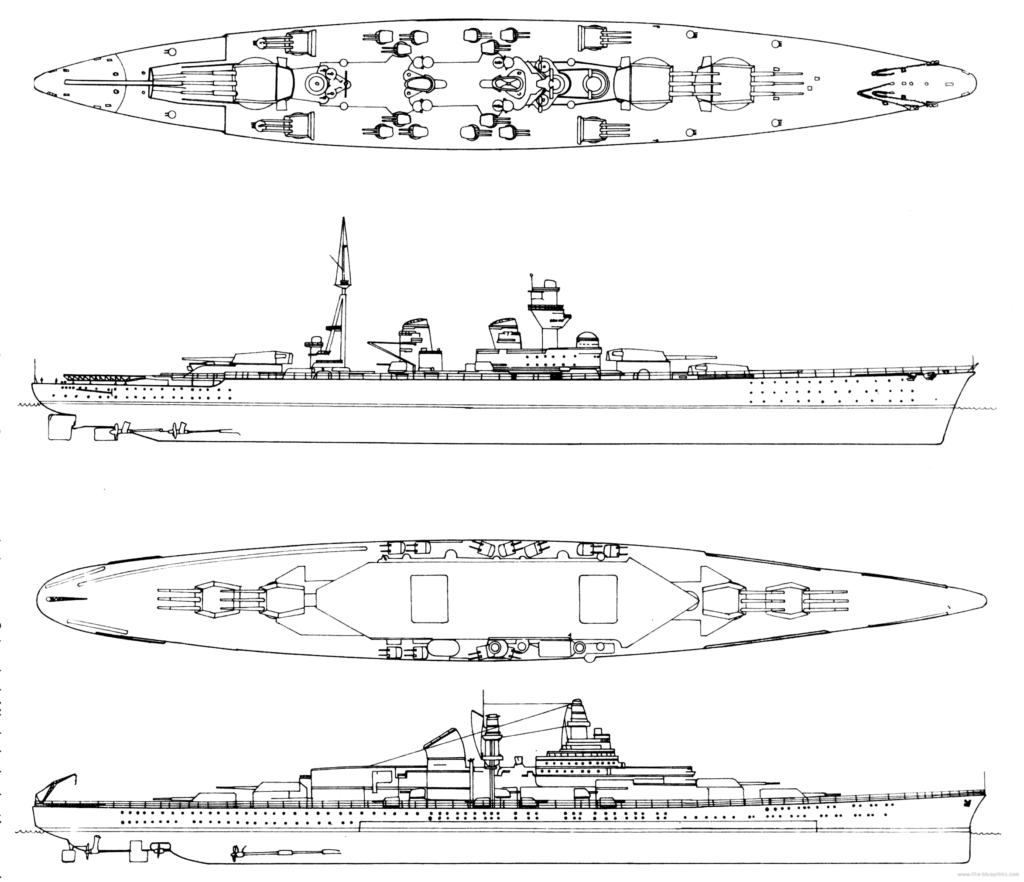
Project UP.41 and its variant, one of the alternative 1930s predecessor design before the Littorio.
Design philosophy behind the Cavour’s reconstruction:
The driving force behind it was Vice Admiral (Generale del Genio navale) Francesco Rotundi. The admiraty by that time were all eyes on the French, as a de facto rivaly existed with the French Republic, due to their conflicting interests (notably colonial) in the Mediterranean, where the bulk of the French Marine Nationale resided. And in 1931, it was known the French planned a new class of modern battleships, the Dunkerque class, trigerred by the German pocket battleships construction (the three Deutschland class). As it was recoignised the current project for a new battleship was nowhere near by that time, Rotundi proposed to the admiralty a stopgap, or interim solution, modernizing the first two Cavour class battleships. However this proposal was quite ambitious and turned to be a radical reconstruction.
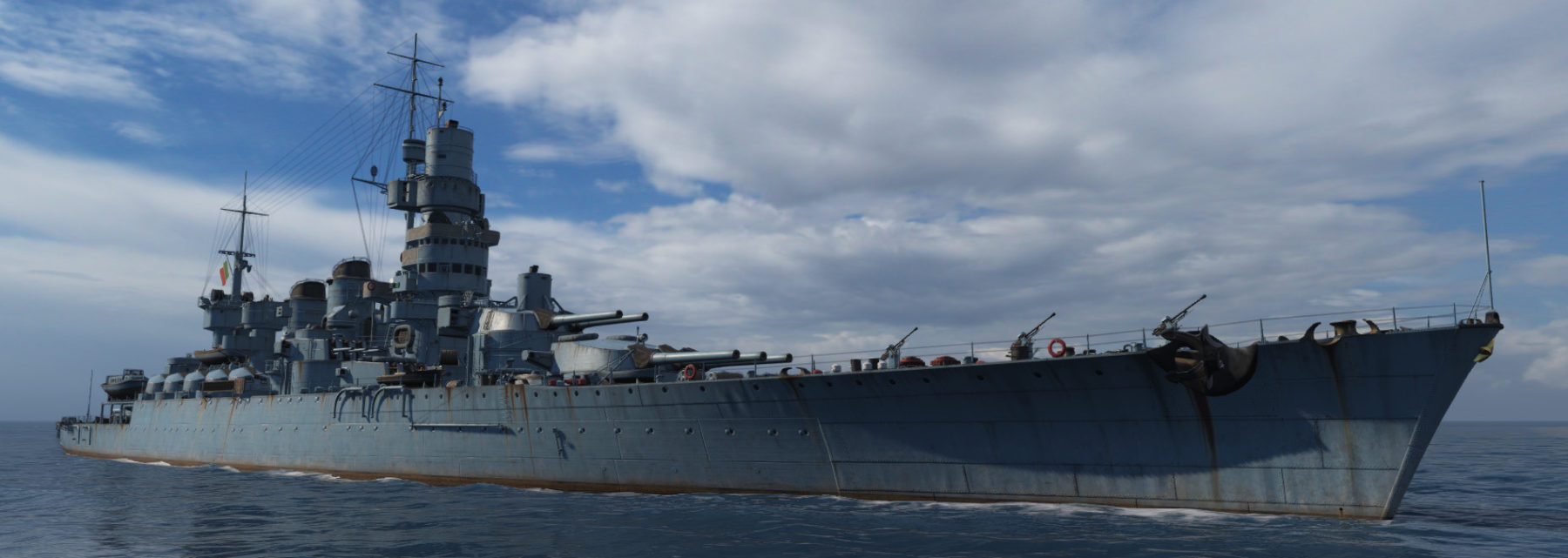
Reconstruction of the Doria (wow)
In October 1933, he went forward submitting the admiralty a radical reconstruction project to keep Italian battleships up to date, circumvent Washington’s treaty limits by avoiding buiding new ones, and test ideas for a future, post-ban treaty fast battleship. After plans were accepted in 1932, the Conte di Cavour was the first taken in hands for a lenghty, and let’s say bluntly, way over budget reconstruction lasting until 1937, June and October for Cavour and Cesare, followed by Doria and Duilio in 1937-40. This reconstruction became the most extensive any battleship experienced at that time and was remarked by engineers and naval staffs around the world for the scope of modified elements in the process. Anything that could be modified was, leaving little but a part of the former subs-sytems intact. The hull was lenghtened with a new clipper bow section to have finer lines, the powerplant entirely rebuilt and modernized, partly to cope with a heavier hull (Cesare reached 28.24 knots (52.30 km/h; 32.50 mph) on post-reconstruction trials), the hull was enlarged by adding the fames Pugliese ASW system, revamped protection all around, rebored main guns with new mounts and turrets for better range and protection and no amidship turret, brand new fire constrol systems and telemeters, brand new superstructures, secondary and AA armament.
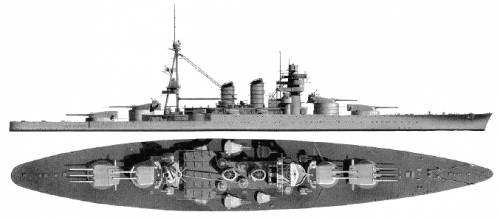
ONI reconstruction drawing of the Cavour class
Due the duration and cost of the project, this reconstruction has been wildly criticized by some naval historians, as these rebuilt capital ships woould prove at posteriori inferior to British battleships they faced, the Queen Elizabeth class. Its staggering cost eventually proved the same as building a brand new Littorio-class battleship. Not only that, due to Italy’s limited resources at that time, it caused bottlenecks in provision of steel plates, which in turn caused long delays for building the Littorio class (eventually this cost the fourth one, RN Impero) which all could have been completed much earlier if the Naval staff limited itself to a simple modernization, of AA and fire control systems for example. Considerable budgets could have been also devoted to research in radar technology for example, probably -seen in the light of WW2- the biggest negligence in that matter for Italian naval planners.
Littorio class (1937)
Battleships Littorio, Vittorio Veneto, Roma, Aquila
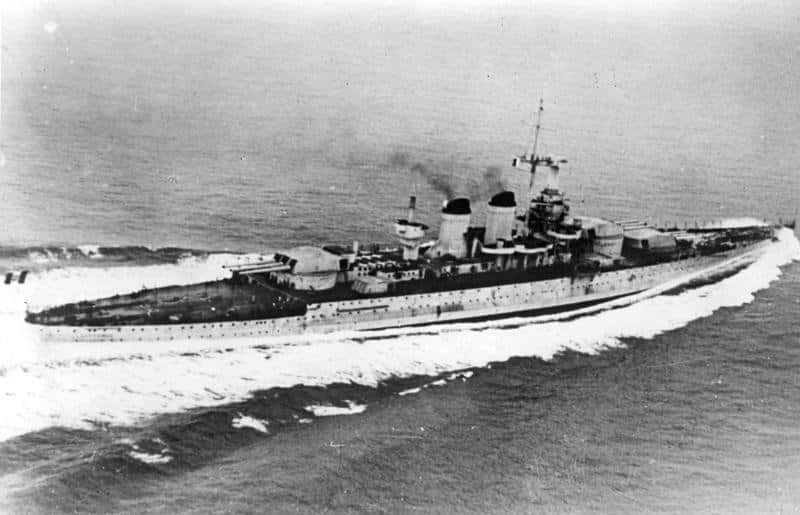
Littorio sailing for completion
Like most of the signatories to the Treaty of Washington in 1922, Italy was found unable to complete her latest battleships already venturing into the “super dreadnought” type contemplated in 1916-1918. The four Caracciolo were indeed capable of 28 knots with eight 381 mm guns, better overall than the British contemporary Queen Elisabeth/Revenge classes. Laid down in 1915, work stopped until 1918 and resumed afterwards, launched in 1920 but never completed, they were demolished because of tonnage limits. In 1932, however, Italy and Japan no longer felt bound to the clauses of the treaty and embarked in the study of a new battleship. At the same time, an industrial basis was developed, including much larger basins to manage the four new battleships, and the delays allowed to test many technological solutions and debate several designs. The Littorio was the result of a ten-years genesis.
Due to the size of the ships, only four could be built, one after over a period spread between launches. The construction of RN Littorio, the class leader started in 1934 along with RN Vitorrio Veneto, followed by RN Italia, Impero never completed. This class was inspired by others such as the French Strasbourg, themselves answering the German Deustchland. The French had chosen a radical forward configuration but the Italians thought after much internal debate and several proposals, that three triple turrets, two forward and one aft, were the best compromise. As a result, they had a sizeable firepower in chase, and this balanced configuration soon became the norm for super-dreadnoughts of the late interwar. It was adopted by the Germans with the Scharnhorst class, Japan with the Yamato class, and of course the United States with three classes. Moreover, these battleships had an unprecedented level of ASW protection with the famous Pugliese system. Thanks to a more advanced machinery rated for 130,000 hp and careful hydrodynamic studies, top speed was 30 knots (54 kph), much better than the rebuilt WW1 battleships of the Cesare/Doria class.
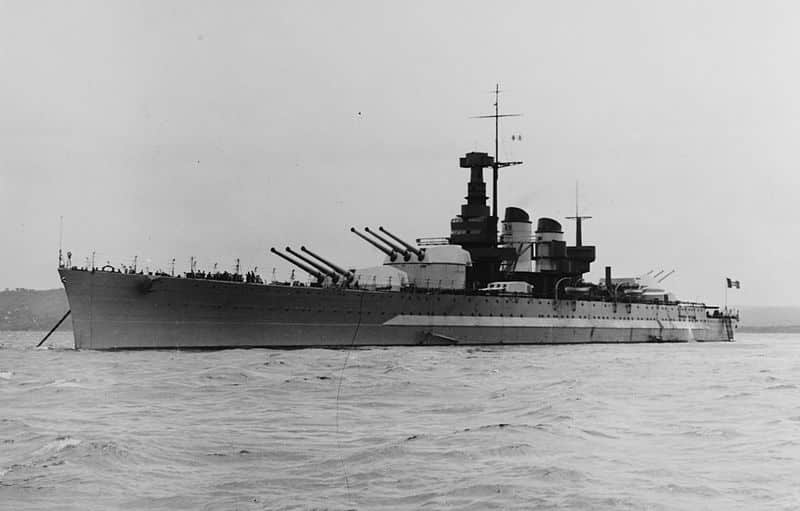
Veneto shortly after completion
The Littorio was built at the Adriatic yards in Trieste, launched on August 2, 1937. RN Veneto was built at Genoa (Ansaldo Yards), launched on July 22, 1937, starting her tests in October 1939, delivered in April 1940 by then incomplete. She joined La Spezia to receive her final equipment and completed in May 1940, sailing to Tarentum. RN Litorrio on her part was completed on the 15 of May, reaching Tarentum. Roma was started at CRDA Trieste in September 1938 and Impero started at Ansaldo in May 1938. Roma was launched in June 1940 and she was completed in June 1942. Impero was launched in November 1939, but never completed. The last pair differed by their elongated hull forward for better sea-keeping and much reinforced AA.
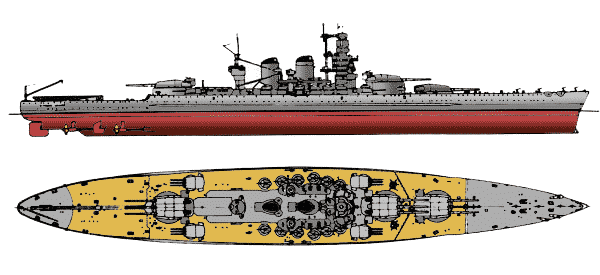
2-view drawing of the Littorio
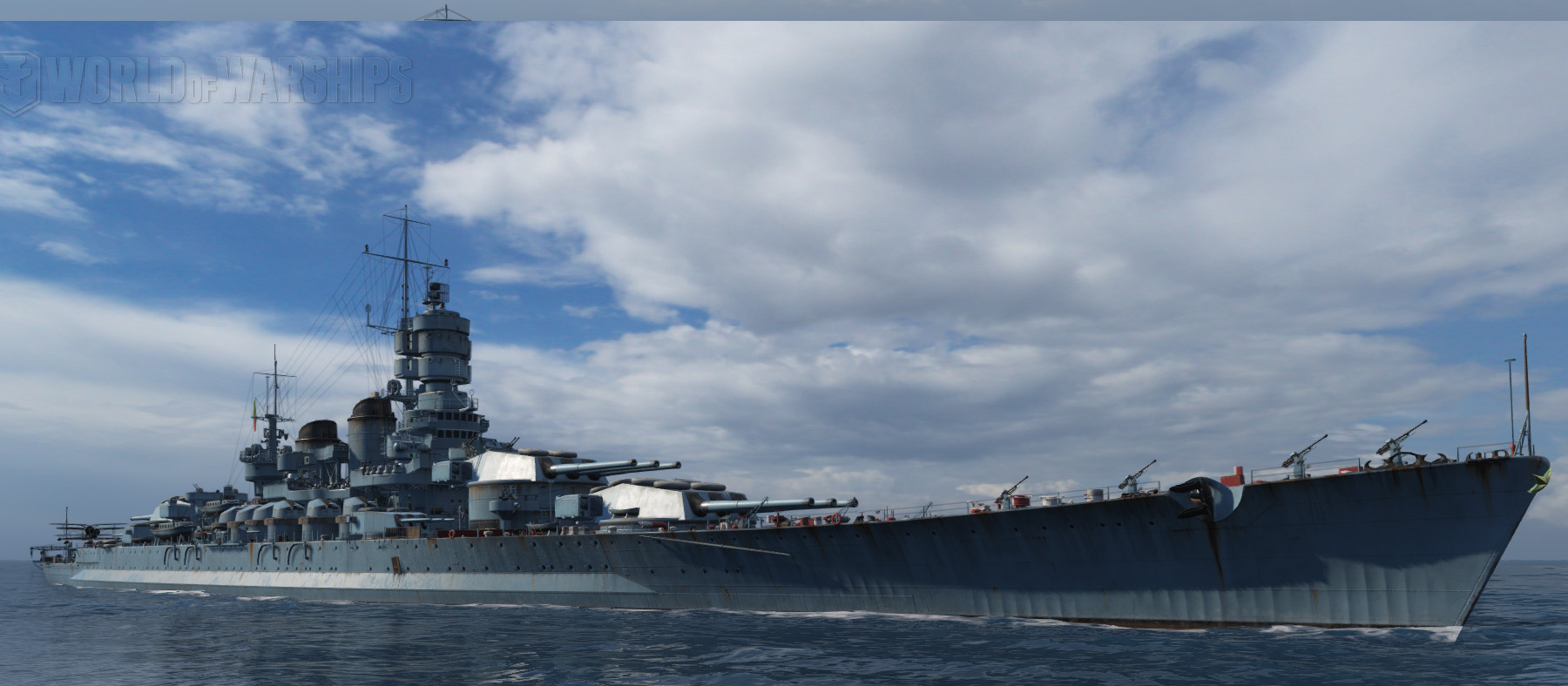
wow’s depiction of Vittorio Veneto
The Littorio class in action
The Littorio and the Veneto were admitted together in active service in August 1940 in the 9th Division, 1st Squadron. The fleet set sail on the 31st with three other battleships, ten cruisers and 31 destroyers to attempt to intercept the British convoy to North Africa without success (HATS operation). The squadron made another sortie to intercept a convoy to Malta on 29 September. During the attack on Taranto on November 12, 1940, the Littorio was struck with two torpedoes and put into action for repair until April 1941. The Veneto escaped this attack and was transferred to Naples. On 26 November he took part in the battle of Cape Spartiviento in the south of Sardinia and was attacked by torpedo planes but succeeded in avoiding torpedoes by manoeuvering as best he could, and for a short time engaged the British cruisers with his artillery for hunting.
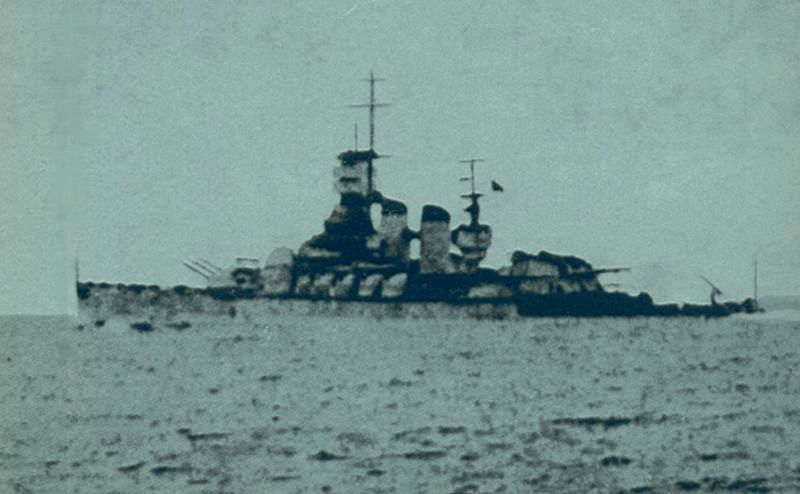
Veneto sailing out of Matapan, torpedoed.
The Veneto escaped bombs during the attack on Naples in January 1941. In February with two other battleships, it made an unsuccessful sortie against the Force H part bombing Genoa. On the 26th of March he set sail to attack the convoys to Greece under German pressure. The Veneto was then engaged in what would become the battle of Cape Matapan, together with the Guilio Cesare. He hired the British cruisers, and underwent a HMS formidable bomber attack. He escaped the first wave but was struck by the second wave of a torpedo with the Pola. He weighed 4000 tons of water and managed to regain Taranto on 29 March. Repairs completed in June. In August 1941, the two vessels met together and operated on the 22nd without meeting the convoy. On the 26th of September they departed to intercept the force sent for Operation Halberd, but they returned to the port when the sortie was canceled. The Veneto found itself escorting a convoy when it was torpedoed by the submarine HMS Urge. His repairs continued until the spring of 1942.
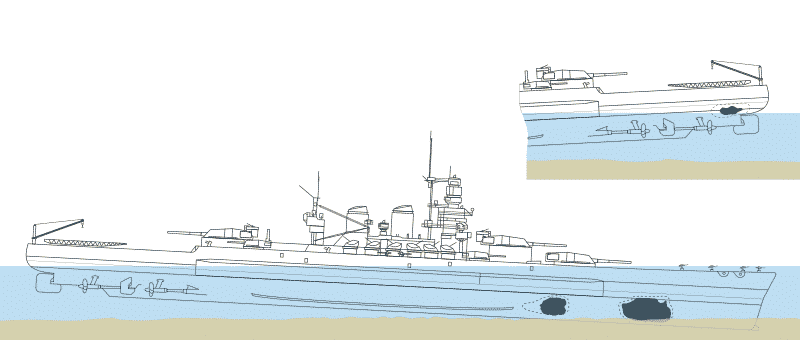
Battle damage of the Litorrio at tarento, 11 November 1940
In December, the Litorrio was engaged during the first battle of the Great Syrta. In January he took part in another engagement in defending a convoy, and in March, during the second battle of the Great Sirte, seriously damaged the destroyers Havock and Kingston. In the spring of 1942, the two vessels found themselves in action against the convoys of malta, coming from Alexandria and Gibraltar. On return, the Littorio was bombarded by a B-24 Liberator (without damage), then torpedoed by a Wellington. He will remain stationary until December. On the 12th the two vessels were sent to La Spezia to respond to Operation Torch. The Roma came to add to the squadron, and the fleet made two sorties against the convoys. Due to the combined fleet forces, however, these sorties were quickly abandoned. In June, the US air force began a series of attacks on La Spezia.
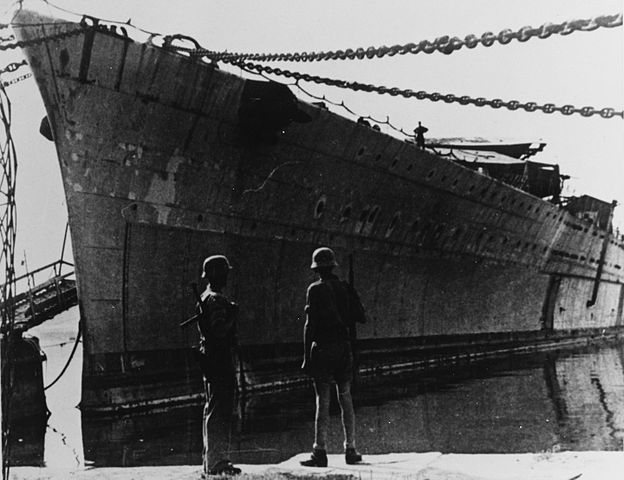
Unfinished Impero under German control.
The Veneto was thus struck by two bombs and was evacuated for repairs to Genoa and did not participate in anything before the armistice. The Litorrio was struck by three bombs and renamed Italia after the fall of Mussolini. The Veneto was also draped twice. In September 1943 the three ships were taken to Malta for internment and attacked on the way by German bombers equipped with the new guided Fritz-X bombs. The Italia was hit at the prow and the battery, the Roma was completely destroyed by an impact in the ammunition hold. From Malta, Italia and Veneto were transferred to Alexandria, anchored in an area of the Suez Canal until the end of the war. In 1946, by virtue of the treaties of peace and reparation, The Veneto was granted to Great Britain, who transferred it to La Spezia. The ship was removed from the lists and bought back for the demolition in 1948, which took place this year, as well as the Italia, granted to the USA. The unfinished Impero served as a test target for the Germans, was then bombed by the US Air Force, then sent to Venice for demolition in 1948.
Litorrio specifications 1940 |
|
| Dimensions | 237 x 32.9 x 10.5m |
| Displacement | 35,000 tonnes /45,700 tonnes FL |
| Crew | 1830-1950 |
| Propulsion | 4 shafts turbines, 8 Yarrow boilers, 130,000 shp |
| Speed | 31 knots (57 km/h) |
| Range | 3,920 mi (6,310 km; 3,410 nmi) at 20 kn |
| Armament | 3×3 381mm, 4×3 155mm, 6×2 90mm AA, 20x 37mm, 30x 20mm Breda AA. |
| Armor | Main belt 350 mm, Deck 162 mm, Turrets, CT 260 mm (10 in) |


Litorrio and Vittorio Veneto, illustrations by the author
Italian Fast battleships projects
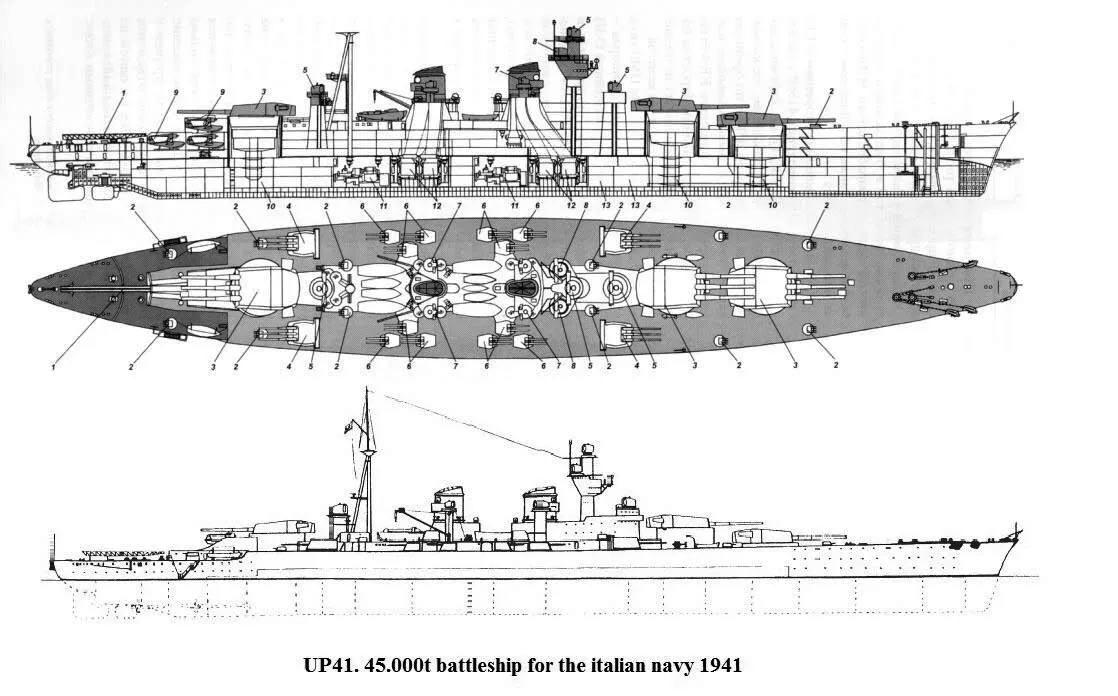
Ansaldo design for a 57,000 tons “super littorio”
There was a projected 50,000 tonnes “super littorio” planned by Ansaldo for the late 1940s. It was basically an enlarged version of Littorio class, but with 16-in guns (406 mm), twelve 152 mm in the same configuration of four triple turrets and the same 24 dual-purpose 90 mm guns in 12 twin turrets, plus an AA composed of 37 mm in twin mounts and 13.2 mm Breda in quadruple mounts, probably over 40.
The Armor was better than the Littorio, with circa 300 mm on the main belt, but moreover 150 mm for the armour deck and a conning tower with 350 mm walls. This design would have been an equivalent of the Soviet-built Sovietsky Soyuz, with the difference the latter had probably the best naval guns in WW2, capable of better ranges than the USN equivalents or even the 18-in guns of the Yamato. These Italian 406mm proceeded from studies that went back all from 1922.
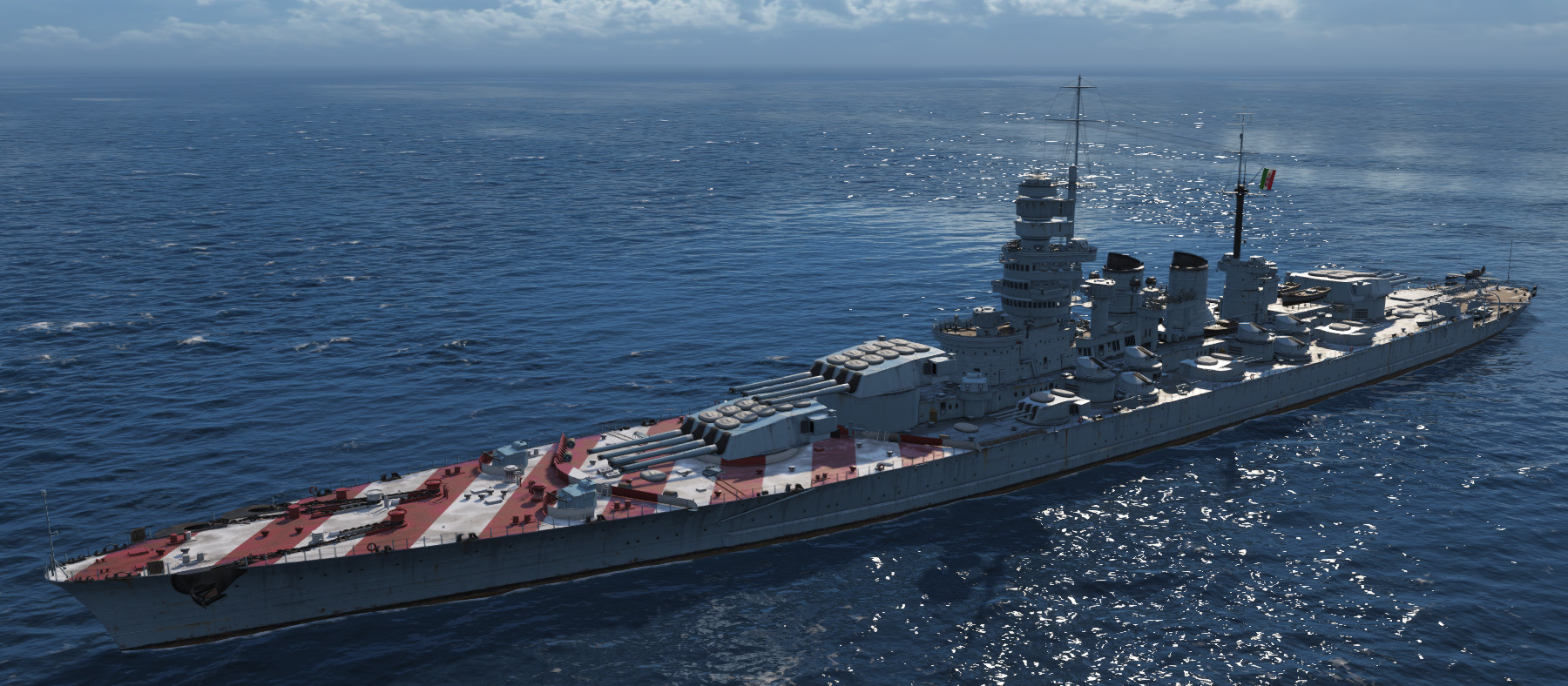
“Lepanto”, presented by wargaming as a “further development of the Vittorio Veneto-class battleships, with her main battery guns placed in quadruple turrets”.

“Colombo”, a world of warship creation around the 50,000 tonnes concept. It is presented as “A large battleship that embodies the Italian shipbuilding achievements of the early 1940s. The ship carried sixteen 381 mm main guns and a strong secondary battery.”
Links/Src
Specs Conway’s all the world fighting ships 1922-1947.
//stefsap.wordpress.com/2017/12/14/rn-francesco-caracciolo-1919-design/
//stefsap.wordpress.com/2015/10/21/cassones-large-battlecruiser-proposal-1921/
reddit.com/r/WarshipPorn/comments/bxkzev/italian_royal_navys_battleship_vittorio_veneto/


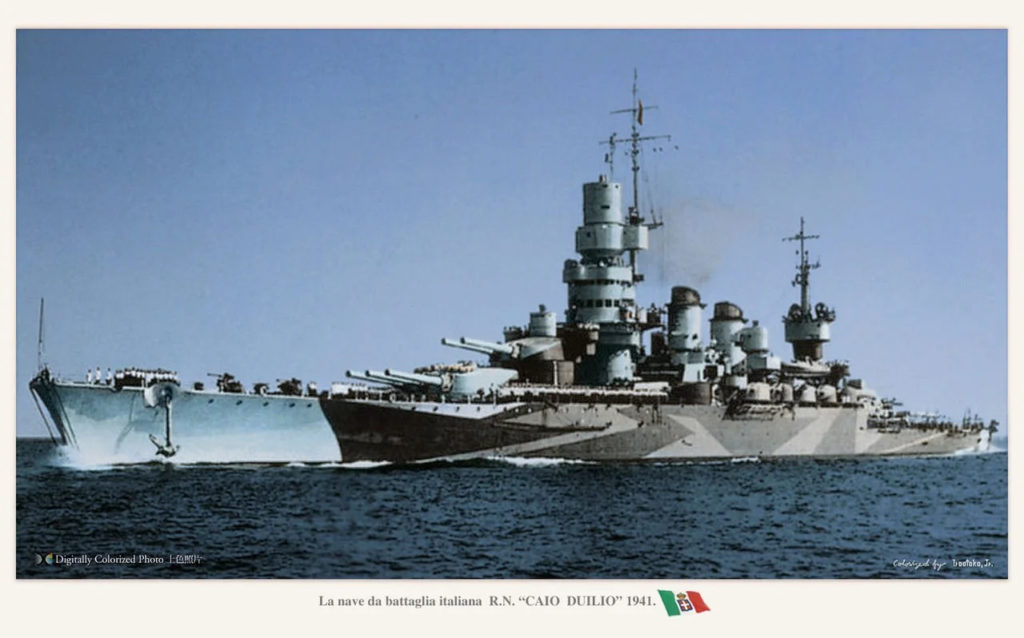
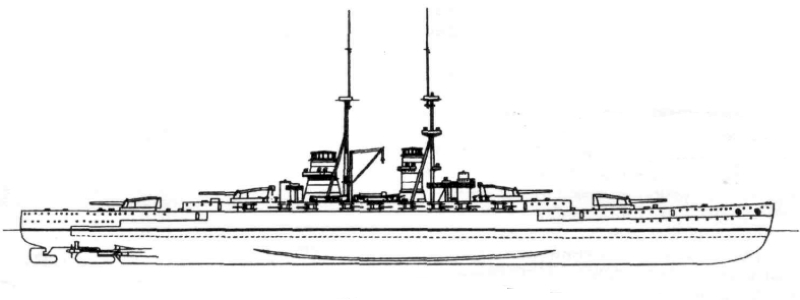
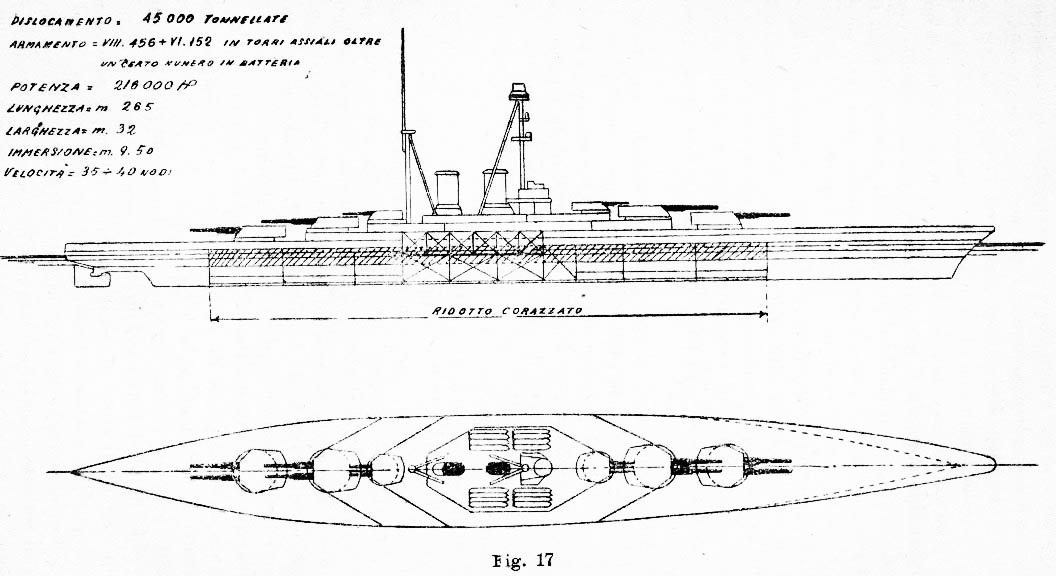
 Latest Facebook Entry -
Latest Facebook Entry -  X(Tweeter) Naval Encyclopedia's deck archive
X(Tweeter) Naval Encyclopedia's deck archive Instagram (@navalencyc)
Instagram (@navalencyc)





 French Navy
French Navy Royal Navy
Royal Navy Russian Navy
Russian Navy Armada Espanola
Armada Espanola Austrian Navy
Austrian Navy K.u.K. Kriegsmarine
K.u.K. Kriegsmarine Dansk Marine
Dansk Marine Nautiko Hellenon
Nautiko Hellenon Koninklije Marine 1870
Koninklije Marine 1870 Marinha do Brasil
Marinha do Brasil Osmanlı Donanması
Osmanlı Donanması Marina Do Peru
Marina Do Peru Marinha do Portugal
Marinha do Portugal Regia Marina 1870
Regia Marina 1870 Nihhon Kaigun 1870
Nihhon Kaigun 1870 Preußische Marine 1870
Preußische Marine 1870 Russkiy Flot 1870
Russkiy Flot 1870 Svenska marinen
Svenska marinen Søværnet
Søværnet Union Navy
Union Navy Confederate Navy
Confederate Navy Armada de Argentina
Armada de Argentina Imperial Chinese Navy
Imperial Chinese Navy Marinha do Portugal
Marinha do Portugal Mexico
Mexico Kaiserliche Marine
Kaiserliche Marine 1898 US Navy
1898 US Navy Sovietskiy Flot
Sovietskiy Flot Royal Canadian Navy
Royal Canadian Navy Royal Australian Navy
Royal Australian Navy RNZN Fleet
RNZN Fleet Chinese Navy 1937
Chinese Navy 1937 Kriegsmarine
Kriegsmarine Chilean Navy
Chilean Navy Danish Navy
Danish Navy Finnish Navy
Finnish Navy Hellenic Navy
Hellenic Navy Polish Navy
Polish Navy Romanian Navy
Romanian Navy Turkish Navy
Turkish Navy Royal Yugoslav Navy
Royal Yugoslav Navy Royal Thai Navy
Royal Thai Navy Minor Navies
Minor Navies Albania
Albania Austria
Austria Belgium
Belgium Columbia
Columbia Costa Rica
Costa Rica Cuba
Cuba Czechoslovakia
Czechoslovakia Dominican Republic
Dominican Republic Haiti
Haiti Hungary
Hungary Honduras
Honduras Estonia
Estonia Iceland
Iceland Eire
Eire Equador
Equador Iran
Iran Iraq
Iraq Latvia
Latvia Liberia
Liberia Lithuania
Lithuania Mandchukuo
Mandchukuo Morocco
Morocco Nicaragua
Nicaragua Persia
Persia San Salvador
San Salvador Sarawak
Sarawak Uruguay
Uruguay Venezuela
Venezuela Zanzibar
Zanzibar Warsaw Pact Navies
Warsaw Pact Navies Bulgaria
Bulgaria Hungary
Hungary

 Bundesmarine
Bundesmarine Dutch Navy
Dutch Navy Hellenic Navy
Hellenic Navy Marina Militare
Marina Militare Yugoslav Navy
Yugoslav Navy Chinese Navy
Chinese Navy Indian Navy
Indian Navy Indonesian Navy
Indonesian Navy JMSDF
JMSDF North Korean Navy
North Korean Navy Pakistani Navy
Pakistani Navy Philippines Navy
Philippines Navy ROKN
ROKN Rep. of Singapore Navy
Rep. of Singapore Navy Taiwanese Navy
Taiwanese Navy IDF Navy
IDF Navy Saudi Navy
Saudi Navy Royal New Zealand Navy
Royal New Zealand Navy Egyptian Navy
Egyptian Navy South African Navy
South African Navy






























 Ukrainian Navy
Ukrainian Navy dbodesign
dbodesign
So much of the Litorrio 1940 specifications are wrong it is not funny. Tonnage is off by over 10,000 tons, 3 triple turrets with guns of roughly 380mm size.
Give you a D- grade.
Apparently it was a copy-past leftover from the Duilio. Fixed. Thanks for spotting !!